Barun Goyot Formation
The Barun Goyot Formation (also known as Baruungoyot Formation or West Goyot Formation) is a geological formation dating to the Late Cretaceous Period. It is located within and is widely represented in the Gobi Desert Basin, in the Ömnögovi Province of Mongolia.
| Barun Goyot Formation | |
|---|---|
| Stratigraphic range: Maastrichtian ~ | |
.JPG.webp) Hermiin Tsav, a highly fossiliferous locality of the formation | |
| Type | Geological formation |
| Underlies | Nemegt Formation |
| Overlies | Djadokhta Formation |
| Thickness | ca. 110 m (360 ft) |
| Lithology | |
| Primary | Sandstone |
| Location | |
| Coordinates | 43.5°N 99.8°E |
| Approximate paleocoordinates | 40.5°N 89.5°E |
| Region | Omnogov |
| Country | |
| Extent | Gobi Desert |
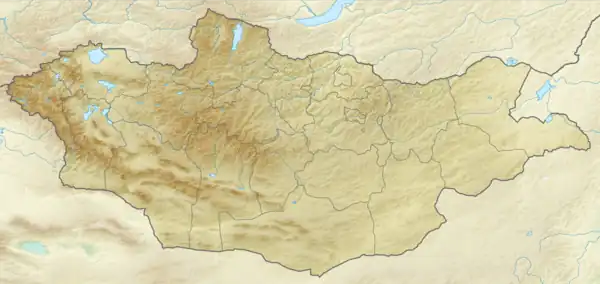 Barun Goyot Formation (Mongolia) | |
Description
It was previously known as the Lower Nemegt Beds occurring beneath the Nemegt Formation and above the Djadokhta Formation. It has been suggested that the Djadokhta and Barun Goyot Formations are lower and upper parts, respectively, of the same lithological unit and the boundary between the two does not exist. The stratotype of the Barun Goyot Formation is the Khulsan locality, east of Nemegt. At Nemegt, only the uppermost barungoyotian beds are visible. The Red Beds of Khermeen Tsav are also considered part of the Barun Goyot Formation. It is approximately 110 metres (360 ft) in thickness,[1] and was laid down roughly 72-71 million years ago. Given the new date for the start of the Maastrichtian (72.1 MYA) a basal Maastrichtian age seems probable. The Barun Goyot Formation preserves an environment of sand dunes, created from wind-eroded rocks (aeolian dunes).
Paleobiota of the Barun Goyot Formation
Color key
|
Notes Uncertain or tentative taxa are in small text; |
Lizards
| Genus | Species | Location | Material | Notes | Images |
|---|---|---|---|---|---|
|
Estesia mongoliensis |
An anguimorph |
||||
| Gobiderma | Gobiderma pulchrum | A Monstersaur | |||
|
Proplatynotia longirostrata |
|||||
Mammals
| Genus | Species | Location | Material | Notes | Images |
|---|---|---|---|---|---|
| Asioryctes | A. nemegtensis | An eutherian. | 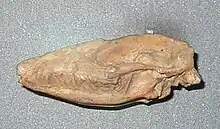 | ||
| Barunlestes | B. butleri | An eutherian. |  | ||
| Catopsbaatar | C. catopsaloides | A djadochtatheriid. | 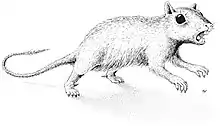 | ||
| Chulsanbaatar | C. vulgaris | A multituberculate. | |||
| Deltatheridium | D. pretrituberculare | A tribosphenid. | |||
| Nemegtbaatar | N. gobiensis | A multituberculate. | 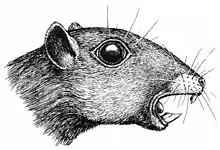 | ||
| Zofialestes | Z. longidens | A eutherian. | |||
Alvarezsaurs
| Genus | Species | Location | Material | Notes | Images |
|---|---|---|---|---|---|
| Ceratonykus | C. oculatus | Hermiin Tsav | "Partial skull with skeleton."[2][3] | An alvarezsaurid. | 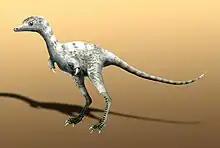 |
| Khulsanurus | K. magnificus | Khulsan | "Partial skeleton, including cervical and caudal vertebrae, scapulocoracoids, humerus, and pubis."[4] | An alvarezsaurid. | |
| Ondogurvel | O. alifanovi | Nemegt | "Partial postcranial skeleton," including dorsal and sacral vertebrae and hip and leg bones.[5] | An alvarezsaurid. |  |
| Parvicursor | P. remotus | Khulsan | "Partial vertebrae, pelvic girdle and hindlimbs."[6] | An alvarezsaurid |  |
Ankylosaurs
| Genus | Species | Location | Material | Notes | Images |
|---|---|---|---|---|---|
| Saichania | S. chulsanensis | Hermiin Tsav II, Khulsan | [Three] skulls, mandibles, cervical vertebrae, dorsal vertebrae, ribs, sternum, scapulocoracoids, humerus, ulna, radius, manus, cervical half-rings, and osteoderms.[7][8][9] | An ankylosaurid also known from the Nemegt Formation. | 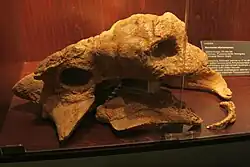 |
| Tarchia | T. kielanae | Hermiin Tsav II, Khulsan | [Two] partial skulls, osteoderms, and [three] undescribed specimens. [8][9] | An ankylosaurid also known from a second species, T. teresae, which was found in the Nemegt Formation. | 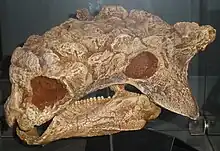 |
| Zaraapelta | Z. nomadis | Hermiin Tsav | A partial skull missing the rostrum. [8] | An ankylosaurid known from a subadult individual. | |
| Ankylosauridae indet. | Indeterminate | Hermiin Tsav | Dorsal vertebrae, ribs, pectoral girdles, forelimbs, pelvic girdles, hindlimbs, and osteoderms. [10] | An ankylosaurid known from a specimen preserved in a "resting posture". | 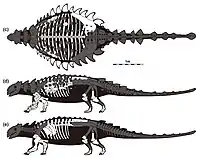 |
Birds
| Genus | Species | Location | Material | Notes | Images |
|---|---|---|---|---|---|
| Gobioolithus | G. major | Gilbent, Khulsan | "Five eggs."[11] | Eggs probably laid by a bird. | |
| G. minor | Hermiin Tsav, Khulsan | "Eggs with embryonic remains."[12][11] | Eggs probably laid by Gobipipus.[12][11] | ||
| Gobipipus | G. reshetovi | Hermiin Tsav, Khulsan | "Embryonic skulls and skeletons."[12] | An enantiornithine. | |
| Gobipteryx | G. minuta | Hermiin Tsav, Khulsan | "Skulls and partial skeletons, and embryonic remains."[13][14][15] | An enantiornithine. Also present in the Djadokhta Formation. | |
| Hollanda | H. luceria | Hermiin Tsav | "Partial hindlimbs from several specimens."[16][17] | An ornithuromorph. | 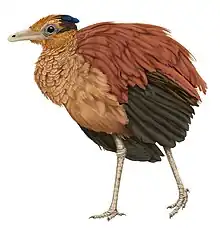 |
| Protoceratopsidovum' | P. fluxuosum | Hermiin Tsav, Khulsan | "Clutch of 19 eggs and isolated eggs."[18] | Eggs probably laid by a bird.[11] | |
| P. minimum | Ikh Shunkht | "Clutch of eggs."[18] | Eggs probably laid by a bird.[11] | ||
| P. sincerum | Hermiin Tsav | "Partial egg."[18] | Eggs probably laid by a bird.[11] | ||
| Styloolithus | S. sabathi | Khulsan | "Partial eggs."[11] | Eggs probably laid by a bird. | |
Ceratopsians
| Genus | Species | Location | Material | Notes | Images |
|---|---|---|---|---|---|
| Bagaceratops | B. rozhdestvenskyi | Hermin Tsav, Khulsan | "Multiple specimens with partial to nearly complete skulls and skeletons."[19][20][21] | A protoceratopsid. Gobiceratops, Lamaceratops, and Platyceratops are now considered synonyms of Bagaceratops.[20] |  |
| Breviceratops | B. kozlowskii | Khulsan | "Two skulls and partial skeleton remains."[22][20] | A protoceratopsid. |  |
| Udanoceratops? | Indeterminate | Baga Tariach | "Partial juvenile specimen."[23] | A giant leptoceratopsid. |  |
Dromaeosaurs
| Genus | Species | Location | Material | Notes | Images |
|---|---|---|---|---|---|
| Kuru | K. kulla | Khulsan | "Fragmentary skeleton."[24] | A dromaeosaurid. |  |
| Shri | S. devi | Khulsan | "Articulated skeleton lacking skull."[25] | A dromaeosaurid. | 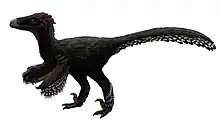 |
| Velociraptorinae indet. | Indeterminate | Hermin Tsav, Khulsan | Not specified.[26][27] | A dromaeosaurid. | |
Halszkaraptorines
| Genus | Species | Location | Material | Notes | Images |
|---|---|---|---|---|---|
| Hulsanpes | H. perlei | Khulsan | Partial foot and skull bone[28] | A halszkaraptorine |  |
| Natovenator | N. polydontus | Hermiin Tsav | Partial articulated skeleton with skull[29] | A halszkaraptorine |  |
Pachycephalosaurs
| Genus | Species | Location | Material | Notes | Images |
|---|---|---|---|---|---|
| Tylocephale | T. gilmorei | Khulsan | "Partial skull."[30][31] | A pachycephalosaurid. | 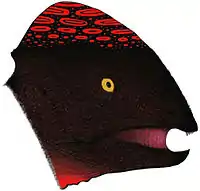 |
Oviraptorosaurs
| Genus | Species | Location | Material | Notes | Images |
|---|---|---|---|---|---|
| Conchoraptor | C. gracilis | Hermin Tsav, Khulsan | "Multiple specimens with skulls and partial skeletons."[32][33][34][35][36] | An oviraptorid. Also present in the Nemegt Formation. |  |
| Heyuannia | H. yanshini | Hermiin Tsav | "Partial skulls and skeletons."[37][35][36] | An oviraptorid. Originally identified as Ajancingenia and "Ingenia". |  |
| Nemegtomaia | N. barsboldi | Nemegt | "Nesting specimen."[38] | An oviraptorid. Also present in the Nemegt Formation. |  |
Sauropods
| Genus | Species | Location | Material | Notes | Images |
|---|---|---|---|---|---|
| Faveoloolithus | F. ningxiaensis | Hermiin Tsav, Ikh Shunkht, Ologoy Ulan Tsav | "Eggs, egg clutches and shells."[39] | Eggs probably laid by a sauropod. | |
| Quaesitosaurus | Q. orientalis | Shar Tsav | "Partial skull."[40] | A titanosaur. | 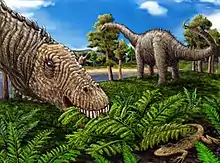 |
Gallery
See also
- List of dinosaur-bearing rock formations
- List of fossil sites (with link directory)
References
- Gradzinski, R.; & Jerzykiewicz, T. (1974). Sedimentation of the Barun Goyot formation. Palaeontologica Polonica, 30, 111-146.
- Alifanov, V. R.; Barsbold, R. (2009). Ceratonykus oculatus gen. et sp. nov., a new dinosaur (? Theropoda, Alvarezsauria) from the Late Cretaceous of Mongolia. Paleontological Journal 43 (1): 94−106.
- Alifanov, V. R.; Saveliev, S. V. (2011). Brain structure and neurobiology of alvarezsaurians (Dinosauria), exemplified by Ceratonykus oculatus (Parvicursoridae) from the Late Cretaceous of Mongolia. Paleontological Journal. 45 (2), 183−190.
- Averianov, Alexander O.; Lopatin, Alexey V. (2021-11-18). "The second taxon of alvarezsaurid theropod dinosaurs from the Late Cretaceous Khulsan locality in Gobi Desert, Mongolia". Historical Biology. 34 (11): 2125–2136. doi:10.1080/08912963.2021.2000976. ISSN 0891-2963. S2CID 244421277.
- Alexander O. Averianov; Alexey V. Lopatin (19 February 2022). "A new alvarezsaurid theropod dinosaur from the Upper Cretaceous of Gobi Desert, Mongolia". Cretaceous Research. 134: 105168. doi:10.1016/j.cretres.2022.105168. S2CID 247000540. Retrieved 19 February 2022.
- Karhu, A. A.; Rautian, A. S. (1996). A new family of Maniraptora (Dinosauria: Saurischia) from the Late Cretaceous of Mongolia. Paleontological Journal. 30, 583−592.
- Carpenter, K., Hayashi, S., Kobayashi, Y., Maryańska, T., Barsbold, R., Sato, K., and Obata, I., 2011, "Saichania chulsanensis (Ornithischia, Ankylosauridae) from the Upper Cretaceous of Mongolia", Palaeontographica, Abteilung A, 294(1-3): 1-61
- Arbour, V. M.; Currie, P. J.; Badamgarav, D. (2014). "The ankylosaurid dinosaurs of the Upper Cretaceous Baruungoyot and Nemegt formations of Mongolia". Zoological Journal of the Linnean Society. 172 (3): 631−652. doi:10.1111/zoj.12185.
- Penkalski, P.; Tumanova, T. (2017). "The cranial morphology and taxonomic status of Tarchia (Dinosauria: Ankylosauridae) from the Upper Cretaceous of Mongolia". Cretaceous Research. 70: 117−127. doi:10.1016/j.cretres.2016.10.004.
- Park, J.-Y.; Lee, Y. N.; Currie, P. J.; Ryan, M. J.; Bell, P.; Sissons, R.; Koppelhus, E. B.; Barsbold, R.; Lee, S.; Kim, S.-H. (2021). "A new ankylosaurid skeleton from the Upper Cretaceous Baruungoyot Formation of Mongolia: its implications for ankylosaurid postcranial evolution". Scientific Reports. 11 (4101): 4101. doi:10.1038/s41598-021-83568-4. PMC 7973727. PMID 33737515.
- Varricchio, D.J.; Barta, D.E. (2015). "Revisiting Sabath's "Larger Avian Eggs" from the Gobi Cretaceous". Acta Palaeontologica Polonica. 60 (1): 11–25.
- Kurochkin, E. N.; Chatterjee, S.; Mikhailov, K. E. (2013). An embryonic enantiornithine bird and associated eggs from the cretaceous of Mongolia. Paleontol. J. 47, 1252–1269.
- Elzanowski, A. (1977). Skulls of Gobipteryx (Aves) from the Upper Cretaceous of Mongolia. Results of the Polish-Mongolian Paleontological Expeditions - Part VII. Palaeontologica Polonica. 37, 153-165.
- Elzanowski, A. (1995). Cretaceous birds and avian phylogeny. Cour. Forschungsinst. Senckenb. 181, 37-53.
- Kurochkin, E. N. (2004). The truth about Gobipteryx. Sixth International Meeting of the Society of Avian Paleontology and Evolution. Abstracts. 33-34.
- Bell, A.K., Chiappe, L.M., Suzuki, S., Watabe, M. (2008). "Phylogenetic and morphometric analysis of a new ornithuromorph from the Barun Goyot Formation, Southern Mongolia." Abstracts of the 7th International Meeting of the Society of Avian Paleontology and Evolution.1.
- Bell, A.K., Chiappe, L.M., Erickson, G.M., Suzuki, S., Watabe, M., Barsbold, R. and Tsogtbaatar, K. (2010). "Description and ecologic analysis of Hollanda luceria, a Late Cretaceous bird from the Gobi Desert (Mongolia)." Cretaceous Research, 31(1): 16-26. doi:10.1016/j.cretres.2009.09.001
- Mikhailov, K. E. (1994). "Theropod and protoceratopsian dinosaur eggs from the Cretaceous of Mongolia and Kazakhstan". Paleontological Journal. 28 (2): 101−120.
- Maryańska, T.; Osmólska, H. (1975). "Protoceratopsidae (Dinosauria) of Asia" (PDF). Palaeontologia Polonica. 33: 134−143. Archived from the original (PDF) on 2018-09-21. Retrieved 2021-05-27.
- Czepiński, Ł. (2019). "Ontogeny and variation of a protoceratopsid dinosaur Bagaceratops rozhdestvenskyi from the Late Cretaceous of the Gobi Desert" (PDF). Historical Biology. 32 (10): 1394–1421. doi:10.1080/08912963.2019.1593404. S2CID 132780322. Archived from the original (PDF) on 2021-07-08. Retrieved 2021-05-27.
- Kim, B.; Yun, H.; Lee, Y.-N. (2019). "The postcranial skeleton of Bagaceratops (Ornithischia: Neoceratopsia) from the Baruungoyot Formation (Upper Cretaceous) in Hermiin Tsav of southwestern Gobi, Mongolia". Journal of the Geological Society of Korea. 55 (2): 179−190. doi:10.14770/jgsk.2019.55.2.179. S2CID 150321203.
- Kurzanov, S. M. (1990). "A new Late Cretaceous protoceratopsid genus from Mongolia". Paleontological Journal. 24: 85−91.
- Tereschhenko, V. S. (2008). "Adaptive Features of Protoceratopsids (Ornithischia: Neoceratopsia)". Paleontological Journal. 42 (3): 50−64. doi:10.1134/S003103010803009X. S2CID 84366476.
- Napoli, J. G.; Ruebenstahl, A. A.; Bhullar, B.-A. S.; Turner, A. H.; Norell, M. A. (2021). "A New Dromaeosaurid (Dinosauria: Coelurosauria) from Khulsan, Central Mongolia" (PDF). American Museum Novitates (3982): 1–47. doi:10.1206/3982.1. hdl:2246/7286. ISSN 0003-0082. S2CID 243849373.
- Turner, A. H.; Montanari, S.; Norell, M. A. (2021). "A New Dromaeosaurid from the Late Cretaceous Khulsan Locality of Mongolia" (PDF). American Museum Novitates (3965): 1−48. doi:10.1206/3965.1. hdl:2246/7251. ISSN 0003-0082. S2CID 231597229.
- Weishampel, D. B.; Barrett, P. M.; Coria, R. A.; Loeuff, J. L.; Xing, X.; Xijin, Z.; Sahni, A.; Gomani, E. M. P. (2004). "Dinosaur Distribution". In Weishampel, D. B.; Dodson, P.; Osmolska, H. (eds.). The Dinosauria (2nd ed.). University of California Press. pp. 596−598. ISBN 0520242092.
- Longrich, N. R.; Currie, P. J.; Dong, Z. (2010). "A new oviraptorid (Dinosauria: Theropoda) from the Upper Cretaceous of Bayan Mandahu, Inner Mongolia". Palaeontology. 53 (5): 945−960. doi:10.1111/j.1475-4983.2010.00968.x.
- Cau, A.; Madzia, D. (2018). "Redescription and affinities of Hulsanpes perlei (Dinosauria, Theropoda) from the Upper Cretaceous of Mongolia". PeerJ. 6: e4868. doi:10.7717/peerj.4868. PMC 5978397. PMID 29868277.
- Lee, Sungjin; Lee, Yuong-Nam; Currie, Philip J.; Sissons, Robin; Park, Jin-Young; Kim, Su-Hwan; Barsbold, Rinchen; Tsogtbaatar, Khishigjav (2022-12-01). "A non-avian dinosaur with a streamlined body exhibits potential adaptations for swimming". Communications Biology. 5 (1): 1185. doi:10.1038/s42003-022-04119-9. ISSN 2399-3642. PMC 9715538. PMID 36456823. S2CID 254128147.
- Maryańska, T.; Osmólska, H. (1974). "Pachycephalosauria, a new suborder of ornithischian dinosaurs" (PDF). Palaeontologica Polonica (30): 45−102.
- Sullivan, R. M. (2006). "A taxonomic review of the Pachycephalosauridae (Dinosauria: Ornithischia)". New Mexico Museum of Natural History and Science Bulletin (35): 347–365.
- Maryańska, T.; Osmólska, H.; Wolsan, M. (2002). "Avialan status for Oviraptorosauria" (PDF). Acta Palaeontologica Polonica. 47 (1): 97−116.
- Kundrat, M. (2007). Avian-like attributes of a virtual brain model of the oviraptorid theropod Conchoraptor gracilis. Naturwissenschaften. 94: 499−504.
- Kundrat, M.; Janacek, J. (2007). Cranial pneumatization and auditory perceptions of the oviraptorid dinosaur Conchoraptor gracilis (Theropoda, Maniraptora) from the Late Cretaceous of Mongolia. Naturwissenschaften. 94(9): 769−778.
- Funston, G. F.; Mendonca, S. E.; Currie, P. J.; Barsbold, R.; Barsbold, R. (2018). "Oviraptorosaur anatomy, diversity and ecology in the Nemegt Basin". Palaeogeography, Palaeoclimatology, Palaeoecology. 494: 101−120. Bibcode:2018PPP...494..101F. doi:10.1016/j.palaeo.2017.10.023.
- Funston, G. F. (2019). "Chapter 4 – Oviraptoridae" (PDF). Anatomy, systematics, and evolution of Oviraptorosauria (Dinosauria, Theropoda) (PhD thesis). University of Alberta.
- Persons, W. S.; Currie, P. J.; Norell, M. A. (2014). "Oviraptorosaur tail forms and functions". Acta Palaeontologica Polonica. doi:10.4202/app.2012.0093.
- Fanti, F.; Currie, P. J.; Badamgarav, D.; Lalueza-Fox, C. (2012). "New specimens of Nemegtomaia from the Baruungoyot and Nemegt Formations (Late Cretaceous) of Mongolia". PLOS ONE. 7 (2): e31330. Bibcode:2012PLoSO...731330F. doi:10.1371/journal.pone.0031330. PMC 3275628. PMID 22347465.
- K. Mikhailov, K. Sabath, and S. Kurzanov. (1994). Eggs and nests from the Cretaceous of Mongolia. In K. Carpenter, K. F. Hirsch, and J. R. Horner (eds.), Dinosaur Eggs and Babies, Cambridge University Press, Cambridge 88-115.
- Kurzanov, S. and Bannikov, A. (1983). "A new sauropod from the Upper Cretaceous of Mongolia". Paleontologicheskii Zhurnal 2: 90–96.
.jpg.webp)
.JPG.webp)
.JPG.webp)


